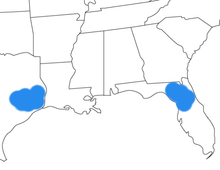Floridachoerus
| Floridachoerus Temporal range: Late Miocene 20.43–15.97Ma | |
|---|---|
| Scientific classification | |
| Kingdom: | Animalia |
| Phylum: | Chordata |
| Class: | Mammalia |
| Order: | Artiodactyla |
| Family: | Tayassuidae |
| Genus: | Floridachoerus Ted E. White, 1941 |
| Species: | F. olseni |
| Binomial name | |
| Floridachoerus olseni (Ted E. White 1941) | |
 | |
| Synonyms | |
|
Desmathyus olseni (Alt. combination) | |
†Floridachoerus olseni was a genus and type of peccary, a ground dwelling omnivore, now extinct having lived during the Hemingfordian age of the Late Miocene, and endemic to North America. F. olseni was in existence for approximately 4.46 million years.[1] Remains of this extinct mammal were located at the fossil rich Thomas Farm site in Gilchrist County, Florida (two collections) and Toledo Bend site, Newton County, Texas.[2] Floridachoerus "olseni" was named after Stanley. J. Olsen of the Florida Geological Survey in 1962. Olsen previously worked at the site for Harvard University.[3]
Sister taxa
Sister taxa: Albanohyus, Antaodon, Cynorca, Doliochoerinae, Macrogenis, Odoichoerus, Platygonus, Prochoerus, Prosthennops, Simojovelhyus, Tayassuinae, Thinohyus, Portheodon.[4] [5]
Lithology of sites
- Thomas Farm site: An ancient sinkhole with an associated cave system not unusual for N. Florida. It's within a calcareous sandstone and blue claystone. The fossils are from multiple horizons including a joint clay; a layer of clayballs, lime sand; a bed of limestone, boulders with gravel and lime sand matrix; and a laminated bluish clay. Most of the material is from the lime sand. The biochronology points to an early Hemingfordian origin through the presence of the ancient bear, Phoberocyon, the mustelid Leptarctus, the rhino Floridaceras, and Metatomarctus, a canid.[6] The Thomas Farm site is located on the Alachua Formation.
- Toledo Bend site: A coarse palaeochannel fill; a conglomerate likely from an episode of violent flood mixing of materials. (Albright, 1999). Also recovered with several mammals including two other Tayassiidae (Cynorca sociale, Hesperhys) three species of rhino, two species of horse, the Dinohyus, Daphoedon, and Nothokemas.
References
- ↑ White, J. Alroy at Fossilworks
- ↑ Toledo Bend collection, Fossilworks
- ↑ Fossilworks full reference identification.
- ↑ Fossilworks: Authority [http://fossilworks.org/bridge.pl?a=referenceInfo&reference_no=937
- ↑ B. J. MacFadden and S. D. Webb. 1982. The succession of Miocene (Arikareean through Hemphillian) terrestrial mammalian localities and faunas in Florida. Florida Bureau of Geology Special Publication 25:186-199. Authorized entry by J. Alroy/J. Alroy
- ↑ Florida Museum of Natural History, Thomas Farm paleontological site
- White, T. E. 1942. The Lower Miocene mammal fauna of Florida. Bulletin of the Museum of Comparative Zoology 92(1):1-49.
| Wikispecies has information related to: Floridachoeus |
| Wikimedia Commons has media related to Floridachoeus olseni. |